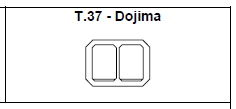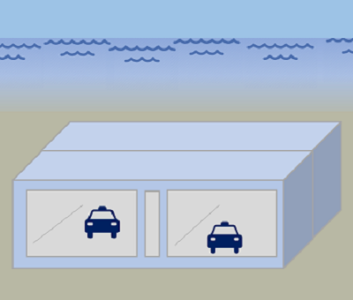Dojima River Tunnel (Osaka Subway Tunnel)
TOTAL IMMERSED LENGTH: 70.5 m
DEPTH AT BOTTOM OF STRUCTURE: 14.3 m
HEIGHT: 8.38 m including a layer of concrete protection 0.50 m thick on the top.
WIDTH: 10.43 m - 11.04 m
ENVIRONMENTAL CONDITIONS: Tidal river.
FABRICATION METHOD:
Reinforced concrete elements were fabricated one by one
in a coffered dock provided near two Nakanoshima
caissons, which later became part of the tunnel. The
elements were enclosed in 6 mm thick steel plate. These
were fabricated in six sections and welded together inside
the cofferdam.
DEPTH AT BOTTOM OF STRUCTURE: 14.3 m
HEIGHT: 8.38 m including a layer of concrete protection 0.50 m thick on the top.
WIDTH: 10.43 m - 11.04 m
ENVIRONMENTAL CONDITIONS: Tidal river.
FABRICATION METHOD:
Reinforced concrete elements were fabricated one by one
in a coffered dock provided near two Nakanoshima
caissons, which later became part of the tunnel. The
elements were enclosed in 6 mm thick steel plate. These
were fabricated in six sections and welded together inside
the cofferdam.
Osaka,
Japan

36 / 34.5 m
70.5m
14.3m
Project construction
1969-04-30
2
Two tubes; one track each
8.38 m including a layer of concrete protection 0.50 m thick on the top.
10.43 m - 11.04 m
Constructed in very tight quarters. Tunnel crossing is askew the Dojima River. Two
elements were immersed between caissons at both banks. Immersed elements were
fabricated inside the excavation for cut-and-cover approach tunnels.
elements were immersed between caissons at both banks. Immersed elements were
fabricated inside the excavation for cut-and-cover approach tunnels.
Reinforced concrete elements were fabricated one by one
in a coffered dock provided near two Nakanoshima
caissons, which later became part of the tunnel. The
elements were enclosed in 6 mm thick steel plate. These
were fabricated in six sections and welded together inside
the cofferdam.
in a coffered dock provided near two Nakanoshima
caissons, which later became part of the tunnel. The
elements were enclosed in 6 mm thick steel plate. These
were fabricated in six sections and welded together inside
the cofferdam.
Tidal river.
Catamaran barges. Water ballast was used for each element.
Single cantilever gasket in combination with heavy
Omega gasket. Space between gaskets was filled with
tremie concrete.
Omega gasket. Space between gaskets was filled with
tremie concrete.
6 mm steel shell all around element.
Screed rails were installed at grade, attached to steel piles. Spreader box was fed by
four hopper pipes. Spreader system was supported on floats and guided by lines from
placement barges. Crushed stone 20 mm to 4 mm in size was placed to form a
foundation course, approximately 0.60 m thick, which was grouted after the elements
were in place.
four hopper pipes. Spreader system was supported on floats and guided by lines from
placement barges. Crushed stone 20 mm to 4 mm in size was placed to form a
foundation course, approximately 0.60 m thick, which was grouted after the elements
were in place.
3.0 m of backfill.
Reinforced

